+ Open data
Open data
- Basic information
Basic information
| Entry | Database: PDB / ID: 1ycr | ||||||
|---|---|---|---|---|---|---|---|
| Title | MDM2 BOUND TO THE TRANSACTIVATION DOMAIN OF P53 | ||||||
 Components Components |
| ||||||
 Keywords Keywords | COMPLEX (ONCOGENE PROTEIN/PEPTIDE) / ANTI-ONCOGENE / DNA-BINDING / TRANSCRIPTION REGULATION / NUCLEAR PROTEIN / COMPLEX (ONCOGENE PROTEIN-PEPTIDE) / PHOSPHORYLATION / ACTIVATOR / COMPLEX (ONCOGENE PROTEIN-PEPTIDE) complex | ||||||
| Function / homology |  Function and homology information Function and homology informationcellular response to vitamin B1 / response to formaldehyde / response to water-immersion restraint stress / response to ether / traversing start control point of mitotic cell cycle / atrial septum development / regulation of protein catabolic process at postsynapse, modulating synaptic transmission / fibroblast activation / Trafficking of AMPA receptors / receptor serine/threonine kinase binding ...cellular response to vitamin B1 / response to formaldehyde / response to water-immersion restraint stress / response to ether / traversing start control point of mitotic cell cycle / atrial septum development / regulation of protein catabolic process at postsynapse, modulating synaptic transmission / fibroblast activation / Trafficking of AMPA receptors / receptor serine/threonine kinase binding / peroxisome proliferator activated receptor binding / negative regulation of intrinsic apoptotic signaling pathway by p53 class mediator / negative regulation of helicase activity / Loss of function of TP53 in cancer due to loss of tetramerization ability / Regulation of TP53 Expression / positive regulation of vascular associated smooth muscle cell migration / signal transduction by p53 class mediator / negative regulation of G1 to G0 transition / negative regulation of glucose catabolic process to lactate via pyruvate / Transcriptional activation of cell cycle inhibitor p21 / regulation of intrinsic apoptotic signaling pathway by p53 class mediator / negative regulation of pentose-phosphate shunt / ATP-dependent DNA/DNA annealing activity / Activation of NOXA and translocation to mitochondria / regulation of cell cycle G2/M phase transition / oligodendrocyte apoptotic process / negative regulation of miRNA processing / intrinsic apoptotic signaling pathway in response to hypoxia / regulation of fibroblast apoptotic process / positive regulation of thymocyte apoptotic process / oxidative stress-induced premature senescence / regulation of tissue remodeling / positive regulation of mitochondrial membrane permeability / negative regulation of protein processing / SUMO transferase activity / mRNA transcription / response to steroid hormone / bone marrow development / positive regulation of programmed necrotic cell death / circadian behavior / T cell proliferation involved in immune response / regulation of mitochondrial membrane permeability involved in apoptotic process / AKT phosphorylates targets in the cytosol / response to iron ion / germ cell nucleus / RUNX3 regulates CDKN1A transcription / NEDD8 ligase activity / atrioventricular valve morphogenesis / homolactic fermentation / TP53 Regulates Transcription of Death Receptors and Ligands / Activation of PUMA and translocation to mitochondria / TP53 regulates transcription of additional cell cycle genes whose exact role in the p53 pathway remain uncertain / histone deacetylase regulator activity / regulation of DNA damage response, signal transduction by p53 class mediator / cellular response to peptide hormone stimulus / endocardial cushion morphogenesis / negative regulation of glial cell proliferation / Regulation of TP53 Activity through Association with Co-factors / ventricular septum development / negative regulation of neuroblast proliferation / mitochondrial DNA repair / T cell lineage commitment / Formation of Senescence-Associated Heterochromatin Foci (SAHF) / positive regulation of muscle cell differentiation / ER overload response / thymocyte apoptotic process / B cell lineage commitment / TP53 Regulates Transcription of Caspase Activators and Caspases / entrainment of circadian clock by photoperiod / cardiac septum morphogenesis / regulation of postsynaptic neurotransmitter receptor internalization / blood vessel development / SUMOylation of ubiquitinylation proteins / negative regulation of mitophagy / ligase activity / cellular response to alkaloid / Constitutive Signaling by AKT1 E17K in Cancer / negative regulation of DNA replication / regulation of protein catabolic process / negative regulation of signal transduction by p53 class mediator / Zygotic genome activation (ZGA) / positive regulation of release of cytochrome c from mitochondria / PI5P Regulates TP53 Acetylation / Association of TriC/CCT with target proteins during biosynthesis / necroptotic process / TP53 Regulates Transcription of Genes Involved in Cytochrome C Release / negative regulation of DNA damage response, signal transduction by p53 class mediator / negative regulation of telomere maintenance via telomerase / TFIID-class transcription factor complex binding / SUMOylation of transcription factors / TP53 regulates transcription of several additional cell death genes whose specific roles in p53-dependent apoptosis remain uncertain / intrinsic apoptotic signaling pathway by p53 class mediator / rRNA transcription / negative regulation of reactive oxygen species metabolic process / Transcriptional Regulation by VENTX / response to magnesium ion / cellular response to UV-C / replicative senescence / protein sumoylation / general transcription initiation factor binding Similarity search - Function | ||||||
| Biological species |  Homo sapiens (human) Homo sapiens (human) | ||||||
| Method |  X-RAY DIFFRACTION / Resolution: 2.6 Å X-RAY DIFFRACTION / Resolution: 2.6 Å | ||||||
 Authors Authors | Kussie, P.H. / Pavletich, N.P. | ||||||
 Citation Citation |  Journal: Science / Year: 1996 Journal: Science / Year: 1996Title: Structure of the MDM2 oncoprotein bound to the p53 tumor suppressor transactivation domain. Authors: Kussie, P.H. / Gorina, S. / Marechal, V. / Elenbaas, B. / Moreau, J. / Levine, A.J. / Pavletich, N.P. | ||||||
| History |
|
- Structure visualization
Structure visualization
| Structure viewer | Molecule:  Molmil Molmil Jmol/JSmol Jmol/JSmol |
|---|
- Downloads & links
Downloads & links
- Download
Download
| PDBx/mmCIF format |  1ycr.cif.gz 1ycr.cif.gz | 31.9 KB | Display |  PDBx/mmCIF format PDBx/mmCIF format |
|---|---|---|---|---|
| PDB format |  pdb1ycr.ent.gz pdb1ycr.ent.gz | 20.8 KB | Display |  PDB format PDB format |
| PDBx/mmJSON format |  1ycr.json.gz 1ycr.json.gz | Tree view |  PDBx/mmJSON format PDBx/mmJSON format | |
| Others |  Other downloads Other downloads |
-Validation report
| Summary document |  1ycr_validation.pdf.gz 1ycr_validation.pdf.gz | 365.6 KB | Display |  wwPDB validaton report wwPDB validaton report |
|---|---|---|---|---|
| Full document |  1ycr_full_validation.pdf.gz 1ycr_full_validation.pdf.gz | 367.7 KB | Display | |
| Data in XML |  1ycr_validation.xml.gz 1ycr_validation.xml.gz | 3.6 KB | Display | |
| Data in CIF |  1ycr_validation.cif.gz 1ycr_validation.cif.gz | 4.8 KB | Display | |
| Arichive directory |  https://data.pdbj.org/pub/pdb/validation_reports/yc/1ycr https://data.pdbj.org/pub/pdb/validation_reports/yc/1ycr ftp://data.pdbj.org/pub/pdb/validation_reports/yc/1ycr ftp://data.pdbj.org/pub/pdb/validation_reports/yc/1ycr | HTTPS FTP |
-Related structure data
- Links
Links
- Assembly
Assembly
| Deposited unit | 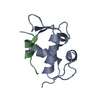
| ||||||||
|---|---|---|---|---|---|---|---|---|---|
| 1 |
| ||||||||
| Unit cell |
|
- Components
Components
| #1: Protein | Mass: 12535.350 Da / Num. of mol.: 1 / Fragment: RESIDUES 17 - 125 Source method: isolated from a genetically manipulated source Source: (gene. exp.)  Homo sapiens (human) / Plasmid: PET3D / Production host: Homo sapiens (human) / Plasmid: PET3D / Production host:  |
|---|---|
| #2: Protein/peptide | Mass: 1807.973 Da / Num. of mol.: 1 / Fragment: RESIDUES 15 - 29 Source method: isolated from a genetically manipulated source References: UniProt: P04637 |
-Experimental details
-Experiment
| Experiment | Method:  X-RAY DIFFRACTION X-RAY DIFFRACTION |
|---|
- Sample preparation
Sample preparation
| Crystal | Density Matthews: 2.09 Å3/Da / Density % sol: 41.03 % | ||||||||||||||||||||||||||||||||||||||||||||||||
|---|---|---|---|---|---|---|---|---|---|---|---|---|---|---|---|---|---|---|---|---|---|---|---|---|---|---|---|---|---|---|---|---|---|---|---|---|---|---|---|---|---|---|---|---|---|---|---|---|---|
| Crystal grow | *PLUS Temperature: 4 ℃ / pH: 6.8 / Method: vapor diffusion, hanging drop | ||||||||||||||||||||||||||||||||||||||||||||||||
| Components of the solutions | *PLUS
|
-Data collection
| Diffraction source | Wavelength: 1.5418 |
|---|---|
| Detector | Type: RIGAKU / Detector: IMAGE PLATE / Date: Jul 25, 1996 |
| Radiation | Monochromatic (M) / Laue (L): M / Scattering type: x-ray |
| Radiation wavelength | Wavelength: 1.5418 Å / Relative weight: 1 |
| Reflection | Num. obs: 3559 / % possible obs: 90 % / Observed criterion σ(I): 0 / Redundancy: 4.5 % / Rmerge(I) obs: 0.052 |
| Reflection | *PLUS Highest resolution: 2.6 Å / Num. measured all: 16069 |
- Processing
Processing
| Software |
| ||||||||||||||||||||||||||||||||||||||||||||||||||||||||||||
|---|---|---|---|---|---|---|---|---|---|---|---|---|---|---|---|---|---|---|---|---|---|---|---|---|---|---|---|---|---|---|---|---|---|---|---|---|---|---|---|---|---|---|---|---|---|---|---|---|---|---|---|---|---|---|---|---|---|---|---|---|---|
| Refinement | Resolution: 2.6→8 Å / σ(F): 1 /
| ||||||||||||||||||||||||||||||||||||||||||||||||||||||||||||
| Refinement step | Cycle: LAST / Resolution: 2.6→8 Å
| ||||||||||||||||||||||||||||||||||||||||||||||||||||||||||||
| Refine LS restraints |
| ||||||||||||||||||||||||||||||||||||||||||||||||||||||||||||
| Software | *PLUS Name:  X-PLOR / Version: 3.1 / Classification: refinement X-PLOR / Version: 3.1 / Classification: refinement | ||||||||||||||||||||||||||||||||||||||||||||||||||||||||||||
| Refinement | *PLUS Rfactor obs: 0.2 / Rfactor Rwork: 0.2 | ||||||||||||||||||||||||||||||||||||||||||||||||||||||||||||
| Solvent computation | *PLUS | ||||||||||||||||||||||||||||||||||||||||||||||||||||||||||||
| Displacement parameters | *PLUS |
 Movie
Movie Controller
Controller



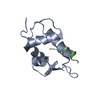
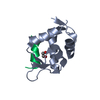
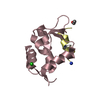

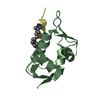
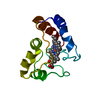


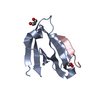


 PDBj
PDBj
















